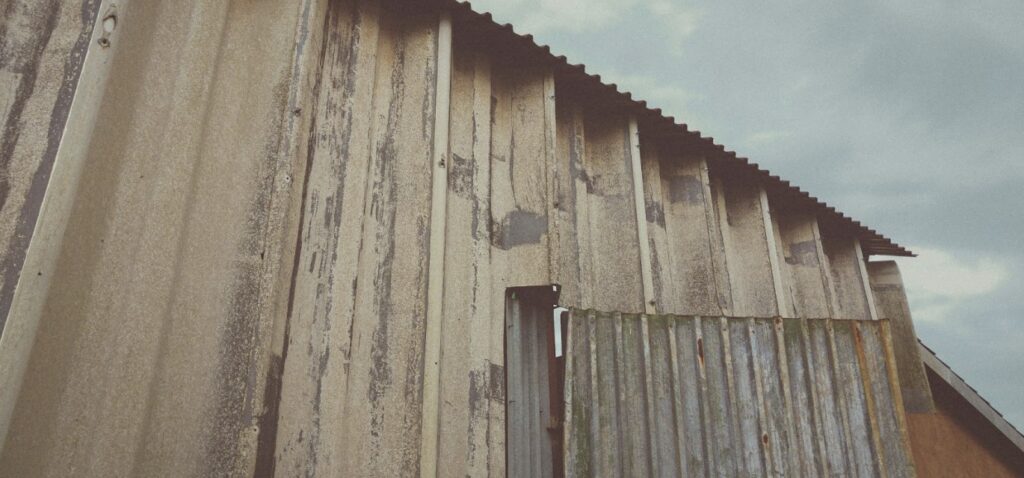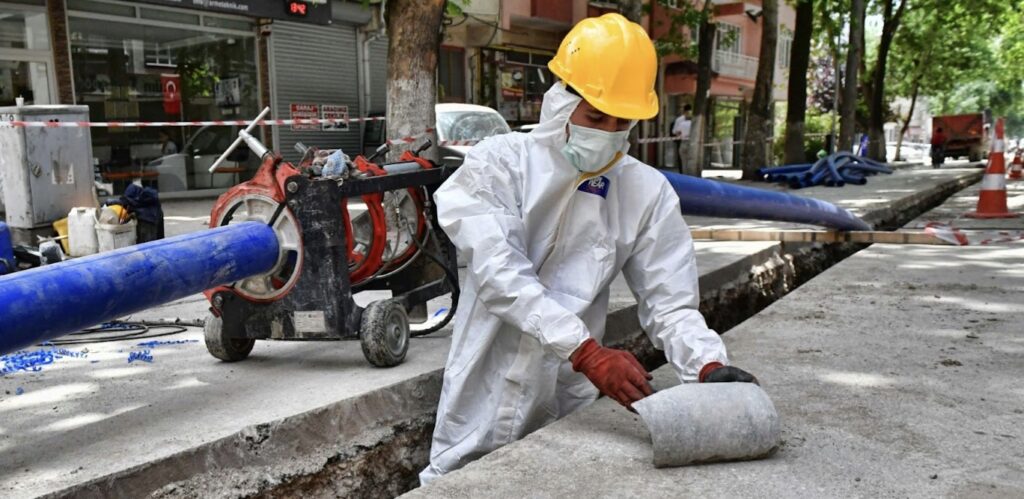Differentiating asbestos varieties matters because fibre morphology directly impacts toxicity, legal categorisation, and required control measures. Accurate identification ensures compliance with UK asbestos regulations and informs safe remediation.
Historically, multiple asbestos types were used across UK buildings from the 1950s through the 1980s. Today, understanding each asbestos type’s risk profile remains critical, particularly during renovations, surveys, or disposal planning.
As older structures continue to age, recognising these distinctions helps reduce asbestos exposure risks and guides appropriate management strategies.
Mineralogical Groups of Asbestos: Serpentine vs Amphibole
Asbestos minerals fall into two groups: serpentine and amphibole. The key characteristics of these types are summarised below:
| Group | Key Type | Fibre Shape | Biopersistence | Typical Risk Level |
|---|---|---|---|---|
| Serpentine | Chrysotile | Curved and flexible | Lower | Medium |
| Amphibole | Amosite, Crocidolite, Anthophyllite, Tremolite, Actinolite | Straight and rigid | High | High |
This structural difference influences how deeply asbestos fibres embed in lung tissue and their clearance rates. These asbestos classifications guide handling protocols, supporting containment, monitoring, and removal standards in regulated environments.

1. Chrysotile (White Asbestos)
Chrysotile fibres, also known as white asbestos, are long, curly, and flexible, making them easier to weave and incorporate into products. In UK construction, chrysotile asbestos-containing material was widely used in roofing felt, pipe insulation, textured coatings, and vinyl floor tiles.
Although chrysotile is considered less hazardous than amphiboles, exposure to it can still lead to serious diseases such as asbestosis, lung cancer, and mesothelioma. Inhalation of this type of asbestos occurs primarily during disturbance of friable materials or damaged insulation. Despite its lower risk rating, chrysotile remains a controlled substance under UK laws regulating asbestos use.
2. Amosite (Brown Asbestos)
Amosite, or brown asbestos, is an amphibole with straight, brittle fibres that embed deeply in lung tissue. It was frequently used in asbestos insulation boards, cement roofing sheets, fire protection panels, and pipe lagging.
The fibre’s durability and sharpness make it particularly dangerous when inhaled. Epidemiological studies regarding asbestos show a strong correlation between amosite exposure and mesothelioma incidence, especially among construction and maintenance workers. Because of its potency, amosite is prioritised in risk assessments and licensed removal projects of asbestos.
3. Crocidolite (Blue Asbestos)
Crocidolite, or blue asbestos, is regarded as the most hazardous type due to its extremely thin, needle-like fibres that are easily inhaled and highly persistent in the lungs. Historically, this type of asbestos was used in spray-applied insulation, gaskets, cement pipes, and marine lagging.
Disease clusters, especially in dockyards and industrial facilities, have been strongly linked to crocidolite exposure. These asbestos fibres are closely associated with rapid-onset mesothelioma, often after relatively brief exposure, making crocidolite a high-priority hazard in remediation protocols.
4. Lesser-Known Amphiboles: Anthophyllite, Tremolite & Actinolite
Anthophyllite, tremolite, and actinolite are rarely used intentionally but appear as asbestos contaminants in minerals like talc and vermiculite. These amphiboles have similar structural traits and toxicological profiles to other high-risk asbestos types.
Though less prevalent in building materials, their presence has been confirmed in imported products and decorative aggregates. Testing for these asbestos fibres is recommended when dealing with suspicious vermiculite insulation or talc-based compounds.
Physical & Chemical Properties of Asbestos Impacting Risk
Key asbestos properties include fibre length, diameter, biopersistence, and thermal stability. These classifications are given below:
| Property | Chrysotile | Amosite/Crocidolite | Risk Impact |
|---|---|---|---|
| Fibre diameter | Thicker | Thinner | Thinner fibres are more respirable |
| Fibre length | Short to medium | Long | Longer fibres lodge deeper in lungs |
| Biopersistence | Moderate | High | Persistent fibres cause prolonged inflammation |
| Thermal stability | Moderate | High | Amphiboles withstand extreme heat |
Health Risks & Comparative Toxicity Linked to Asbestos
Asbestos fibres cause harm through mechanical irritation and cellular inflammation, leading to fibrosis, genetic damage, and eventually cancer. Here is a summary of their comparative toxicity:
- Chrysotile (White asbestos) – Considered the least toxic but still dangerous; linked to asbestosis, lung cancer, and lower incidence of mesothelioma due to its lower biopersistence and curly fibre structure.
- Amosite (Brown asbestos) – Poses a significantly higher risk; associated with mesothelioma, lung cancer, and pleural thickening, owing to its sharp, brittle fibres and greater lung retention.
- Crocidolite (Blue asbestos) – The most toxic form; causes mesothelioma at the highest rate, alongside lung cancer and asbestosis, due to its extremely fine, needle-like fibres and high biopersistence.
- Tremolite, Actinolite & Anthophyllite – Though less commonly encountered, these amphiboles are highly toxic; linked to mesothelioma, lung scarring, and pleural plaques, particularly when inhaled over time through contaminated products.
Identification, Sampling & Laboratory Analysis of Asbestos
Initial identification of asbestos relies on visual inspections for suspect materials like insulation boards, ceiling panels, and sprayed coatings. Asbestos sampling must follow strict procedures, including PPE use and chain-of-custody documentation.
Various analytical methods are used to confirm asbestos presence and type, each with distinct capabilities and limitations:
- Polarised Light Microscopy (PLM) – A widely used method for bulk material analysis; effective for identifying asbestos type but has limited sensitivity for very fine fibres.
- Transmission Electron Microscopy (TEM) – Offers high-resolution imaging for extremely thin fibres; ideal for air samples and trace detection, but involves higher costs and longer processing times.
- Scanning Electron Microscopy (SEM) – Provides detailed surface imagery and fibre morphology; suitable for assessing complex or contaminated samples, with moderate detection capability.

Removal & Encapsulation of Different Asbestos
The management approach for asbestos varies by fibre type due to differences in friability and toxicity.
- Chrysotile – Being less friable, it can often be safely managed in place through encapsulation, where a durable sealant is applied to prevent fibre release without disturbing the material.
- Amosite – With a brittle structure and higher potential for fibre release, it is less suited to long-term encapsulation and typically requires removal or secure enclosure to reduce exposure risk.
- Crocidolite – Due to its extreme toxicity and fine, highly respirable fibres, it poses an unacceptable risk if left in place and should always be prioritised for licensed removal under controlled conditions.
While encapsulation can extend the safe lifespan of lower-risk materials, more hazardous amphiboles demand permanent remediation strategies to ensure long-term safety from asbestos-related risks.
